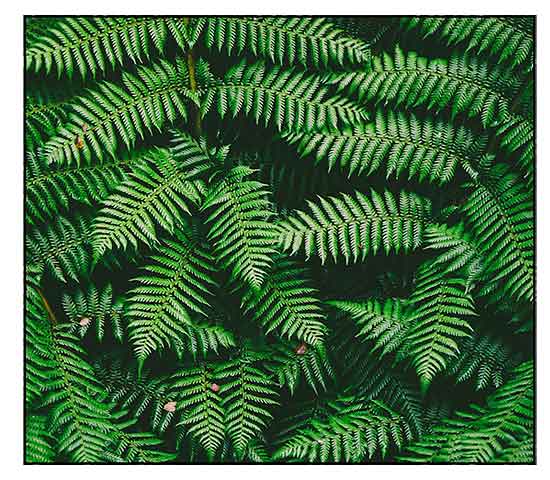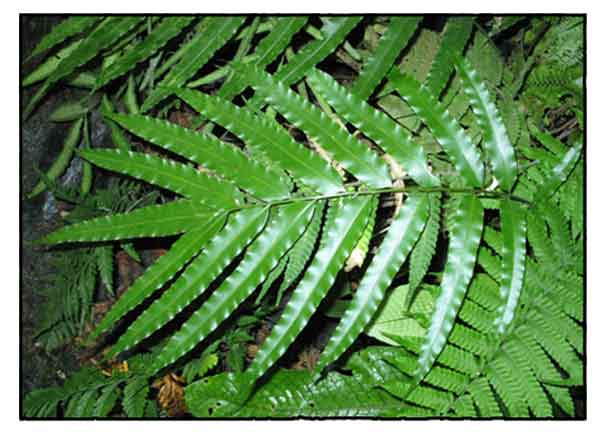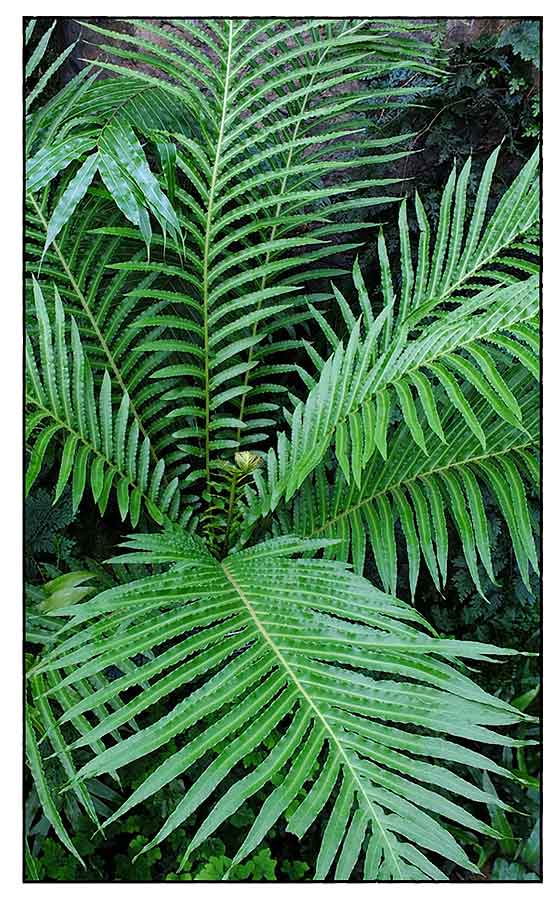 Gen info Gen info
- Etymology: The genus name Stenochlaena means "narrow cloak" referring to the sporangia covering the entire surface of the linear fertile pinnae. The specific epithet palustris is Latin for "of the marsh"or "swampy ground" referring to its common habitat.
- The district of Diliman in Quezon City, one of the Philippines' important education district, is said to be named after the fern.
(3)
Botany
Stems long creeping and climbing; scales at apex of rhizome dark brown to black, orbicular, ovate, or ovate-lanceolate, ca. 1 mm in diam., caducous. Fronds distant, dimorphic. Stipe 10-80 cm, glabrous; lamina 1-pinnate, oblong in outline, 50-80 × 20-30 cm; lateral pinnae 8-16 pairs, terminal pinna similar; pinnae very shortly stalked, articulate to rachis; sterile pinnae broadly lanceolate or oblong-lanceolate, (10-)15-20 × 2-4.5 cm, varying much in size and shape, leathery or stiffly papery, surface smooth and glossy, base broadly cuneate, margin sharply and irregularly serrate, apex acuminate or sometimes caudate; fertile pinnae 10-20 × 0.1-0.5 cm, linear. Veins simple or forked, forming single row of narrow costal areoles. Sori acrostichoid, covering whole abaxial surface of fertile pinnae. (Flora of China)
 Distribution Distribution
- Native to the Philippines.
- Also native to Assam, Australia, Bangladesh, Bismarck Archipelago, Borneo, Cambodia, Caroline Is., China, Fiji, Hainan, India, Jawa, Laos, Lesser Sunda Is., Malaya, Maluku, Myanmar, Nepal, New Guinea, Nicobar Is., Northern Territory, Queensland, Samoa, Solomon Is., Sri Lanka, Sulawesi, Sumatera, Thailand, Tonga, Vietnam, Wallis-Futuna Is. (2)
- In open places and secondary forests, from sea level to 400 m in China. Widely distributed in thickets, swampy places near the sea.
Constituents
- Study of leaves isolated five new O-acylated flavonol glycosides, stenopalustrosides A-E (1-5), along with five known compounds, kaempferol 3-O-(3‘ ‘-O-E-p-coumaroyl)−(6‘ ‘-O-E-feruloyl)-β-d-glucopyranoside (6), kaempferol 3-O-(3‘ ‘,6‘ ‘-di-O-E-p-coumaroyl)-β-d-glucopyranoside (7), kaempferol 3-O-(3‘ ‘-O-E-p-coumaroyl)-β-d-glucopyranoside (8), kaempferol 3-O-(6‘ ‘-O-E-p-coumaroyl)-β-d-glucopyranoside (9); and kaempferol 3-O-β-d-glucopyranoside (10). (see study below) (5)
- Study of leaves isolated a
novel glycoside, (4S*,5R*)4-[(9Z)-2,13-di-(O-beta-D-glucopyranosyl)-5,9, 10-methyl-8-oxo-9-tetradecene-5-yl] -3,3,5-trimethylcyclohexanone, namely stenopaluside, and a new cerebroside 1-O-beta-D-glucopyranosyl-( 2S*,3R*,4E,8Z)-2-N- [(2R)-hydroxytetracosanoyl) octade-casphinga-4,8-dienine, along with four known natural products, 3-oxo-4,5-dihydro-alpha-ionyl beta-D-glucopyranoside, 3-formylindole, lutein, and beta-sitosterol-3-O-beta-D-glucopyranoside. (8)
- Phytochemical study of ethanol extract of kelakai leaves yielded alkaloids, alcohols, amines, amine alcohols, amino acids, fatty acids, flavonoids, glycosylglucose. lipid derivatives, monocarboxylic acid, saponins, steroids, and terpenoids. (25)
- Kelakai leaves extract showed very strong antioxidant potential (IC50 42.47 µg/mL), with total phenol content of 193.97 mg GAE/g, total flavonoid 23.45 QE/g, and total alkaloid 11.74 mg CE/g.  (25)
Properties
- Studies have suggested antioxidant, antibacterial, antiplasmodial, cholinesterase inhibitory, alpha-glucosidase inhibitory, antitermite, cytotoxicity, anticancer, antiobesity, sunscreen, adipocyte-suppressing, anti-melatotoxic properties.
Parts used
Leaves, shoots, stems, juice.
 Uses Uses
Edibility
- Fronds are edible; young shoots eaten raw or cooked. In Malaysia, eaten like spinach.
- In Sarawak, where the plant is called "Midin", young fronds are served stir-fried with garlic, dry shrimps, or shrimp paste. (3) (Shelf life of Midin is short, turning black a day after harvesting, even with refrigeration. Drying can extend the lifespan of Midin, with potential as delicacy in wider markets.) (22)
-
In Sabah, where it is called "Lembiding", it is usually cooked with sardines or belacan. In Vietnam, young fronds are called dot choai and used in soups, salads, and stir-fried dishes. (3)
Folkloric
- In India and Malaysia, leaves used as remedies for fever, skin diseases, ulcers, and stomachaches.
- In Indonesia, used for wound healing, infection, and diabetes.
- In Sumatra, vegetable eaten for gentle laxative effect. In Malaysia, decoction or juice of shoots taken internally for fever; externally, infusion is used for moistening the head of person with fever. In Thailand, juice used for skin diseases. In the Nicobar Islands, used as abortifacient and contraceptive. (1)
- The Dayak people in Central Kalimantan use the kelakai plant to cure acne, applying finely ground leaves and stems to the affected skin. (20)
- In Thailand, whole plant decoction used to treat fever. In Kerala, India, leaf juice used for fever. Among the Chakma tribal community in Dharmapur, Bangladesh, paste of leaves is applied twice daily on the scrotum to treat testicular atrophy. (21)
Others
- Rope: Stems are noted for durability when submerged in salt water; used fro tying bamboo frames of fish traps. Fiber used as inferior substitute for rattan. Stems used for making ropes and belts. (1)(4)
- Others: Used as an ornamental, the black rhizomes sometimes applied as a wig to supplement thinning hair. (1)
Studies
• Antibacterial / Flavanol Glycosides / Leaves: Study of leaves isolated five new O-acylated flavonol glycosides, stenopalustrosides A-E )1-5), along with five known compounds. Compounds 1-4 showed significant antibacterial activities against Gram-positive strains. (see constituents above) (5)
• Antioxidant / Phenolics and Flavonoids / Leaves: Study evaluated ethanol and ethyl acetate extracts for antioxidant activity and total phenolics and flavonoids contents. Ethanolic leaf extract showed higher phenolics and flavonoids compared to other plant extracts. Ethanol leaf extract exhibited highest antioxidant activities with FRAP, ABTS. and DPPH assays values of 17.95mM Fe+/g, 0.062 mM TE/g, and IC50 of 24.24 µg/mL, respectively. (6)
• Cholinesterase Inhibitory Activity / Maturity Stages of Fronds: Study evaluated the anticholinesterase properties and phytochemical profiles of young and mature fronds of S. palustris. Both types of fronds showed selective inhibitory effect against butyrylcholinesterase compared with acetylcholinesterase. In young fronds, antibutyrylcholinesterase effect was observed with the hexane extract, which was comprised of a variety of aliphatic hydrocarbons, fatty acids and phytosterols. In mature fronds, inhibitory activity was observed with the methanol extract, which contained a series of kaempferol glycosides. (7)
• Use as Edible Coating / Increased Shelf Life of Fruits: Study evaluated the antimicrobial and antioxidant effects of compounds of Stenochlaena palustris and Diplazium esculentum incorporated with 1.5% of sodium alginate edible coating. S. palustris extracts helped minimized pH change, maintain total soluble solids level, prevent drastic color change of the fruits, and reduce microbial growth (p<0.05). D. esculentum helped maintain ideal gas composition, retain fruit firmness, minimize loss of titrable acidity. Overall, use of both S. palustris and D. esculentum with MAP extended shelf life of figs for 25 days. Results suggest potential for a low cost, practical, and straightforward technique for enhancement of shelf life of exotic fruits to support small-scale farmers and producers. (9)
• Antioxidant / Antiplasmodial / Antibacterial / Aerial Parts: Study evaluated extracts of aerial parts of S. palustris for free radical scavenging activity, antiplasmodial activity, toxicity and antibacterial activity. The ethyl acetate extract showed potential free radical scavenging activity by DPPPH and NO assays with IC50s of 51.63 µg/mL and 60.03 µg/mL, respectively. Against Plasmodium falciparum, the EA showed potential activity with IC50 of 11.06 µg/mL. All extracts showed no toxicity against Artemia salina with LC50>1000 µg/mL. The EA showed intermediate susceptibility against B. cereus ATCC 10876, V. parahaemolyticus ATCC 17802, L. monocytogenes ATCC 7644, and S. Typhimurium ATCC 14028 at a concentration of 500 μg/disc. Results showed the EA extract as a promising source of natural antioxidants and antiplasmodial agents. (10)
• Anti-termite / Antiplasmodial / Antibacterial / Stems: Study evaluated effects of fractions of S. palustris stems and isolated constituents on termite mortality and paper disc consumption by Coptotermes curvignathus. Phytochemical study isolated major constituents, of which
20-hydroxyecdysone exhibited highest termiticidal activity, followed by stenopalustroside A and ajugasterone C. Structure-activity relationships (SAR) of synthetic derivatives from 20-hydroxyecdysone and augasterone C suggested a 2,3-diol has considerable effect on the antitermite properties. (11)
• α-Glucosidase / Antioxidant: Study isolated a potent antiglucosidase and antioxidant fraction from Stenochlaena palustris. A methanol extract showed most active antiglucosidase, DPPH scavenging, and ferric reducing antioxidant power (FRAP). The water fraction (WF) of ME showed stronger α-glucosidase inhibition (EC50 2.9 µg/mL) than quercetin, with weak antiamylase activity. The WF was a competitive
α-glucosidase inhibitor. DPPH scavenging of WF (EC50 7.7 µg/mL) was weaker than quercetin, but was a stronger H2O2 scavenger than gallic acid (EC50 838 µg/mL). The WF possessed moderate copper chelating activity. WF was enriched in total phenolics and hydroxycinnamic acids. Overall, the WF exhibited both potent antiglucosidase and antioxidant activities. (12)
• Antimicrobial / Leaves, Stems, Roots: Study evaluated methanol extracts from winged bean Stenochlaena palustris root, stem, and leaves for antimicrobial activity against 15 species viz., 10 bacterial pathogens, one yeast, and four molds using disc diffusion assay. The leaf extract was found to be most effective against all tested organisms, followed by stem and root extracts. Leaf extract MICs ranged from 50 to 12.5 mg/mL. (13)
• Antimalarial / Plasmodium berghei Infection and Splenomegaly / Leaves: Study evaluated the antimalarial activity of ethanol extract of kelakai leaves to parasitemia and splenomegaly of Plasmodium berghei ANKA in infected BALB/c mice. Chloroquine diphosphate was positive control. Results showed parasitemia growth inhibition was directly proprotional to the dose. Results suggest good antimalarial activity with no correlation between extract doses and splenomegaly. (14)
• Cytotoxicity to MCF-7 Breast Cancer Cell Line: Breast cancer ranks fifth among all types of cancer with 6.6% mortality. Study evaluated the cytotoxicity of ethanol extract of S. palustris extract against MCF-7 breast cancer cell line. Doxorubicin was used as positive control. Results of cytotoxicity assay showed toxic effect on MCF-7 cells with IC50 of 493.57 µg/ml. (15)
• Adipocyte Suppression Activity / Antiobesity: Study evaluated S. palustris for bioactivities that can alleviate obesity i.e., lipase inhibitory activity and inhibition of lipid accumulation in 3T3-L1 adipocytes. A water extract showed highest lipase inhibition while the methanol extract showed highest lipid accumulation inhibition in adipocytes. The lipase inhibitory activity and suppression of lipid accumulation in adipocytes provide potential for future research on obesity management. (16)
• Alpha-Glucosidase Inhibitory Activity: Study showed S. palustris exhibited active glucosidase inhibitory activity on sucrase and maltase and anti-amylase activity. Kaempferol 3-O-ß-glucopyranoside or astralgin was isolated and is highly possible it is the major compound responsible for the S. palustris maltase inhibitory activity. (17)
• Sunscreen Potential of Emulgel
/ Roots: Ethanol extract of kalakai root has shown strong antioxidant effects and an SPF value of extreme ability level. Study evaluated the sunscreen potential of emulgel kalakai roots ethanol extract at 1% and 2% concentration. Both 1% and 2% formulations of emulgel root met organoleptic test quality parameters, pH, and spreadability test. (18)
• Antibacterial: Study evaluated S. palustris for antibacterial effect against bacterial in skin infections, using disc diffusion method. The acetone extract demonstrate antibacterial activity. Pseudomonas aeruginosa, a bacterium frequently associated with nosocomial infection, was the most sensitive organism of the tested bacteria. Activity was attributed to flavonoids, phenols, polyphenols, and sterols in the acetone extract. MIC was 12.5 mg/ml and MBC was 25.0 mg/ml towards P. aeruginosa. (19)
• Increased Life Span of Dried Midin: Shelf life of Midin is short, turning black a day after harvesting, even with refrigeration. Study evaluated the quality of dried Midin fern after rehydration. Water activity in fresh Midin was greatly reduced after oven drying, slowing down deterioration, and last longer. Dried Midin regained its turgidity and firmness after rehydration. All sensory characteristics of cooked rehydrated Midin were comparable with cooked fresh Midin. While there were significant differences in moisture, protein, ash, fat, and carbohydrate contents between fresh and rehydrated Midin, fiber content showed no significant difference. Short blanching and rehydration time is vital in reducing nutrient loss. Drying can extend the lifespan of Midin, with potential as delicacy in wider markets. (22)
• Phytosterols / Anti-Breast Cancer: Study evaluated the potential of phytosterols from S. palustris as estrogen receptor (ER) inhibitors. Phytosterols (alpha tocopherol, beta sitosterol, campesterol, stigmasterol, fucosterol) were docked to estrogen receptor (PDB ID: 7KBS). Alpha-tocopherol showed highest interaction with the estrogen receptor. It showed not hepatotoxicity and no skin sensitization. Results suggest phytosterols from potential anti-breast cancer activity via suppression of ERa and may be used to prevent estrogen-dependent human cancers like breast cancer. (23)
• Anti-Metalotoxic / Cadmium-Induced Liver Damage / Leaves: Study evaluated the anti-metalotoxic activity of leaf extract of S. palustris on cadmium (Cd)-induced liver tissue damage. The leaf extract significantly reduced the levels of all measured parameters (MDA, carbonyl compound, conjugated dienes, and advanced oxidation protein products) in liver tissue. Results suggest Cd could induce liver tissue damage and S. palustris showed anti-metalotoxic activity to reduce the damage. (24)
• Effect on Food Borne Pathogen, Aspergillus niger / Leaves: Study evaluated the antifungal activity of S. palustris leaf extract against food borne pathogen, Aspergillus niger. The crude extract caused more severe injury to hyphae than spores. As incubation period for treatment increased, the cell wall of elongated hyphae flattened and broke in halves; spores became emaciated as treatment progressed. Results showed S. palustris has promise as a safe alternative natural product-based food preservative. (26)
Availability
Wild-crafted. |

![]()






